Sigma DP1
-
-
Written by Gordon Laing
Sigma DP1 resolution comparison
| Support this site by shopping via these links | ||||||||||||||||||||||||||||||||||||||||
 |
To measure and compare the Sigma DP1’s resolving power we photographed the Enhanced Digital Camera Resolution Chart with it and a number of rival cameras, each using their best quality JPEG and default image tone and sharpening settings. Each lens was tested at every aperture setting and the best result selected for this page. The crops are taken from the original images, saved as High Quality JPEGs in Photoshop CS2 and presented here at 100%. Each number represents 100 lines per picture height (lpph), so a figure of 20 means a resolution of 2000 lpph. |
Note: just before going to press with this review, Sigma released firmware revision 1.03 which added a new LOW 50 ISO option, so we reshot this test and have presented the results below – although in terms of resolved detail, it was no different to the 100 ISO shot. The Sigma DP1’s relatively low 4.69 Megapixel output is responsible for the larger than average area shown in the crops below, but there’s still a respectable degree of detail in the image. You’ll also notice that while there are patches where the converging lines become blurred, the DP1’s Foveon X3 sensor avoids the moiré patterns associated with conventional Bayer pattern sensors as they approach their limiting resolution. These blurred portions actually start as low as 1400 lpph, but are followed by patches of perfectly resolved detail. So we’re giving the DP1 the benefit of the doubt and scoring it here at the last point you can resolve the lines as being separate: this gives the DP1 1750 lpph of horizontal and vertical resolution respectively. This is unsurprisingly lower than the other cameras shown here as their higher pixel density allows them to achieve a higher spatial resolution. But when it comes to colour resolution and avoiding colour artefacts, the DP1’s X3 sensor technology is superior. Either way though, not a bad result for a camera outputting 4.69 Megapixel images. As explained on the previous page, the DP1 comes with RAW processing software which offers an interpolated mode with 13.9 Megapixels, so to see how this measures-up, scroll down to the bottom of the page. Alternatively if you can’t wait to see how it’s sensitivity performance compares, head straight over to our DP1 noise results page. |
Sigma DP1 |
Canon EOS 450D / XSi with EF-S 18-55mm IS | |
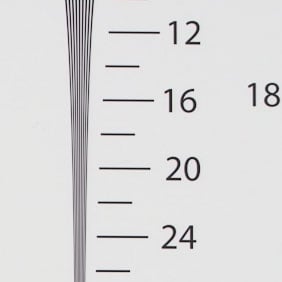 | 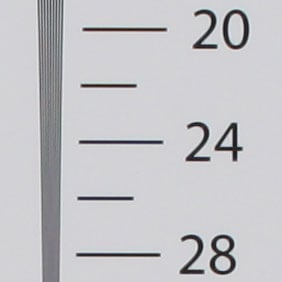 | |
1750 lpph, 16.6mm at f5.6, 50 ISO |
2200 lpph, EF-S 18-55mm IS at 35mm, f8, 100 ISO | |
Canon PowerShot G9 |
Panasonic Lumix FX500 | |
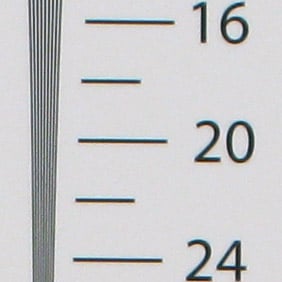 | 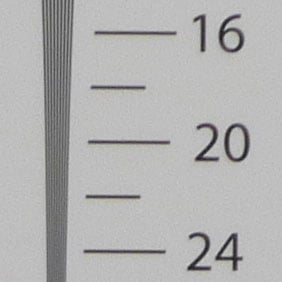 | |
2250 lpph, 7.4-44.4mm at 15mm, f4, 80 ISO |
2100 lpph, 4.4-22mm at 10mm, f4.5, 100 ISO |
Sigma DP1 |
Canon EOS 450D / XSi with EF-S 18-55mm IS | |
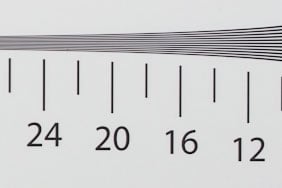 | 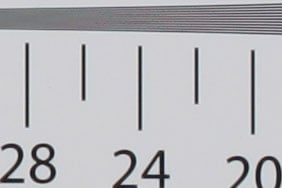 | |
1750 lpph, 16.6mm at f5.6, 50 ISO |
2225 lpph, EF-S 18-55mm IS at 35mm, f8, 100 ISO | |
Canon PowerShot G9 |
Panasonic Lumix FX500 | |
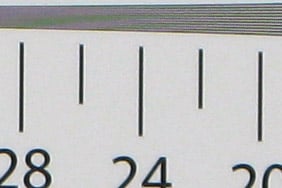 | 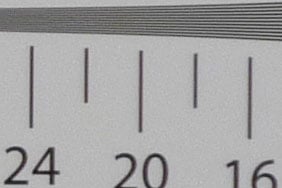 | |
2250 lpph, 7.4-44.4mm at 15mm, f4, 80 ISO |
2150 lpph, 4.4-22mm at 10mm, f4.5, 100 ISO |
Sigma DP1 Studio resolution: JPEG versus RAW
We photographed the chart immediately afterwards using the DP1’s RAW mode (annoyingly it doesn’t offer a RAW plus JPEG option). The RAW file was then processed using Sigma’s supplied Photo Pro software, using the default settings, although we exported the image using the Large 13.9 Megapixel option. This interpolates the image and allows us to really see how much detail is captured by the system.
The interpolated RAW image is certainly very smooth and ideal for outputting at larger print sizes, but it doesn’t contain any greater detail than the JPEG. Once again, blurred patches occur from 1400 lpph onwards, followed by small windows where the lines are perfectly resolved. And as before, the highest resolution where the lines remain separate is at around 1750 lpph.
So we’d say while the 13.9 interpolated output from RAW files will avoid jaggies on large prints, it won’t manage to eek out any additional detail over the JPEG original. Now let’s see how performs at different sensitivities on our DP1 noise results page.
Sigma DP1 JPEG |
Sigma DP1 RAW (13.9 Large output) | |
 | 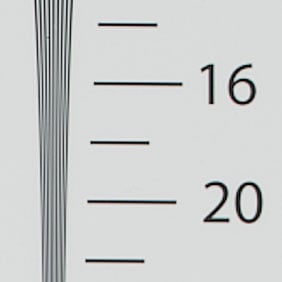 | |
1750 lpph, 16.6mm at f5.6, 50 ISO |
1750 lpph, 16.6mm at f5.6, 50 ISO |
Sigma DP1 JPEG |
Sigma DP1 RAW (13.9 Large output) | |
 | 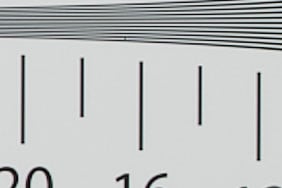 | |
1750 lpph, 16.6mm at f5.6, 50 ISO |
1750 lpph, 16.6mm at f5.6, 50 ISO |




